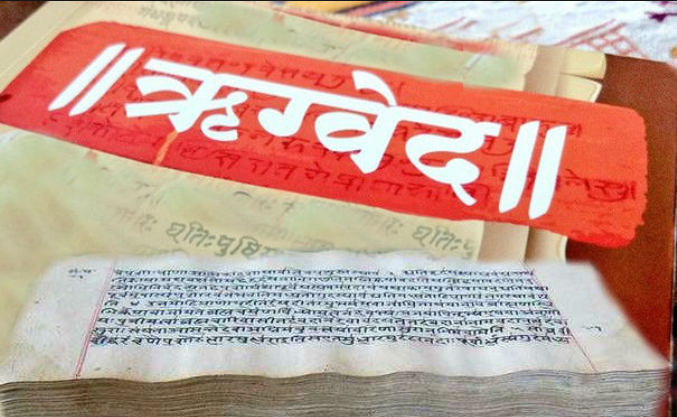Description of the Four Vedas in Hindu Scripture
Also discrive of 4 th type of veda in brief
The Rigveda ;The Rigveda is the oldest and most important of the four Vedas in the Hindu scripture. It is believed to have been composed between 1700-1100 BCE and contains a collection of hymns and prayers addressed to various deities.
The Rigveda is divided into ten books, or mandalas, with a total of 1,028 hymns or suktas. The hymns are composed in Vedic Sanskrit and are organized by theme and purpose. They are primarily used for ritualistic purposes and contain descriptions of the gods, their powers, and their relationships with each other.
The Rigveda is divided into three main sections: the Samhitas, the Brahmanas, and the Aranyakas. The Samhitas are the hymns themselves, while the Brahmanas are commentaries on the hymns and provide instructions on how to perform rituals. The Aranyakas are philosophical treatises that explore the nature of reality and the self.
The Rigveda contains hymns addressed to various deities, including Indra, Agni, and Soma, among others. These deities represent various aspects of nature and the cosmos, and the hymns praise them for their power and influence.
The Rigveda is an important part of Hindu scripture and has had a profound impact on Hindu culture and religion. It is considered to be a valuable source of knowledge about ancient Indian civilization and is still studied and revered by Hindus around the world.
The Samaveda; The Samaveda is one of the four Vedas in the Hindu scripture, and it is primarily concerned with music and chants used in worship. It is believed to have been composed around 1000-800 BCE and is considered to be the shortest of the four Vedas.
The Samaveda is a collection of hymns from the Rigveda that have been set to music. The hymns are sung in a specific manner during the performance of rituals and sacrifices. The Samaveda is divided into two main parts: the Purvarchika, which contains hymns used in the morning ritual, and the Uttararchika, which contains hymns used in the evening ritual.
The Samaveda is known for its use of melody and rhythm in the recitation of the hymns. The musical notation used in the Samaveda is unique to this Veda and is considered to be the oldest surviving music system in the world.
In addition to its musical focus, the Samaveda also contains philosophical teachings on topics such as the nature of reality and the self. It explores the concept of Brahman, the ultimate reality that underlies all existence, and discusses the importance of meditation and self-realization in achieving spiritual liberation.
Overall, the Samaveda is an important part of Hindu scripture and provides valuable insights into ancient Indian beliefs and practices. Its focus on music and melody highlights the importance of sound and rhythm in Hindu worship and the role of music in creating a sacred atmosphere.
The Yajurveda ; The Yajurveda is one of the four Vedas in the Hindu scripture, and it is primarily concerned with ritualistic practices and sacrifices. It contains mantras or hymns for use in the performance of these rituals, as well as instructions on how to perform them.
The Yajurveda is divided into two main parts: the Shukla Yajurveda and the Krishna Yajurveda. The Shukla Yajurveda is also known as the Vajasaneyi Samhita and is the more popular of the two. It contains hymns that are arranged in a specific order to be recited during the performance of rituals. The Krishna Yajurveda, on the other hand, contains the same hymns as the Shukla Yajurveda, but they are presented in a different order.
The Yajurveda is primarily used in the performance of fire sacrifices or yajnas, which are considered to be an important part of Hindu rituals. The mantras in the Yajurveda are recited during the performance of these sacrifices to invoke the gods and seek their blessings.
In addition to its ritualistic focus, the Yajurveda also contains philosophical teachings on topics such as the nature of reality and the self. It explores the concept of Brahman, the ultimate reality that underlies all existence, and discusses the importance of meditation and self-realization in achieving spiritual liberation.
Overall, the Yajurveda is an important part of Hindu scripture and provides valuable insights into ancient Indian beliefs and practices. Its focus on ritualistic practices and sacrifices highlights the importance of these practices in Hindu culture and religion.
The Atharvaveda ; The Atharvaveda is the fourth and final Veda in the Hindu scripture. It is believed to have been composed around 1200 BCE, making it slightly younger than the other three Vedas.
The Atharvaveda consists of 20 books or sections, known as kandas, which contain a total of 730 hymns and 6,000 mantras. Unlike the other three Vedas, which primarily deal with rituals and sacrifices, the Atharvaveda focuses more on domestic and personal life.
The hymns in the Atharvaveda address a wide range of topics, including healing, protection, and prosperity. They contain spells and incantations for healing diseases and averting evil, as well as prayers for success in love, marriage, and childbirth. The hymns also touch on social issues, such as the duties of a king and the importance of charity.
One of the notable features of the Atharvaveda is its inclusion of magic and sorcery. Some of the hymns contain spells and incantations for controlling or harming others, which has led to some controversy and criticism.
Despite its focus on domestic and personal life, the Atharvaveda also contains philosophical teachings similar to those found in the other three Vedas. It explores the concept of Brahman, the ultimate reality that underlies all existence, and discusses the importance of meditation and self-realization in achieving spiritual liberation.
Overall, the Atharvaveda provides valuable insights into ancient Hindu beliefs and practices and is an important part of the Hindu scripture.















0 Comments